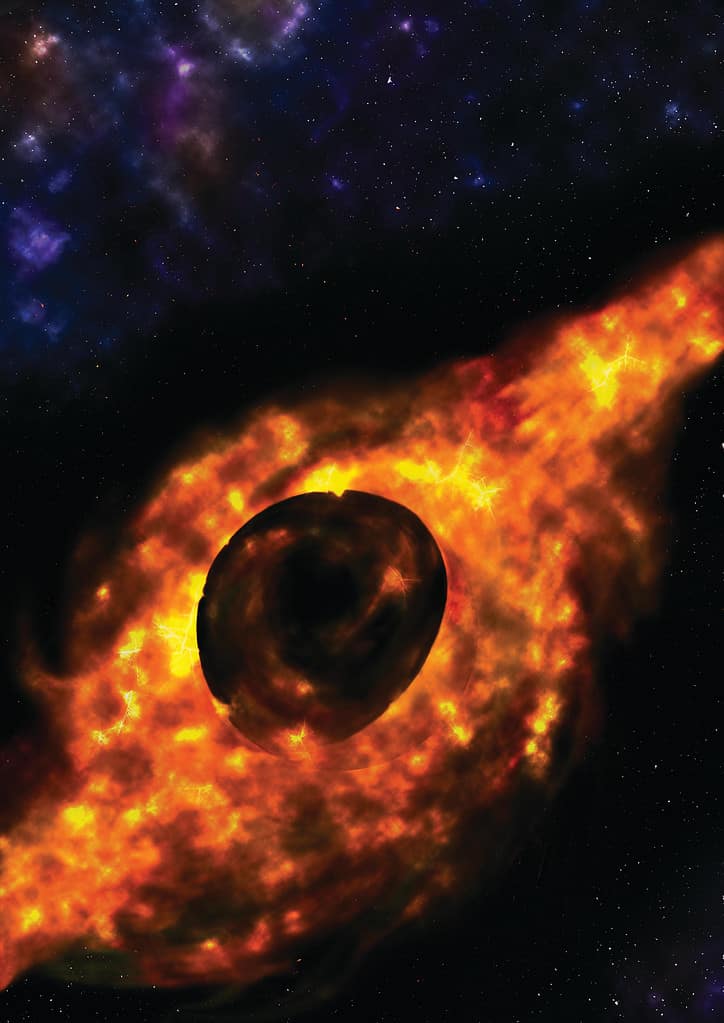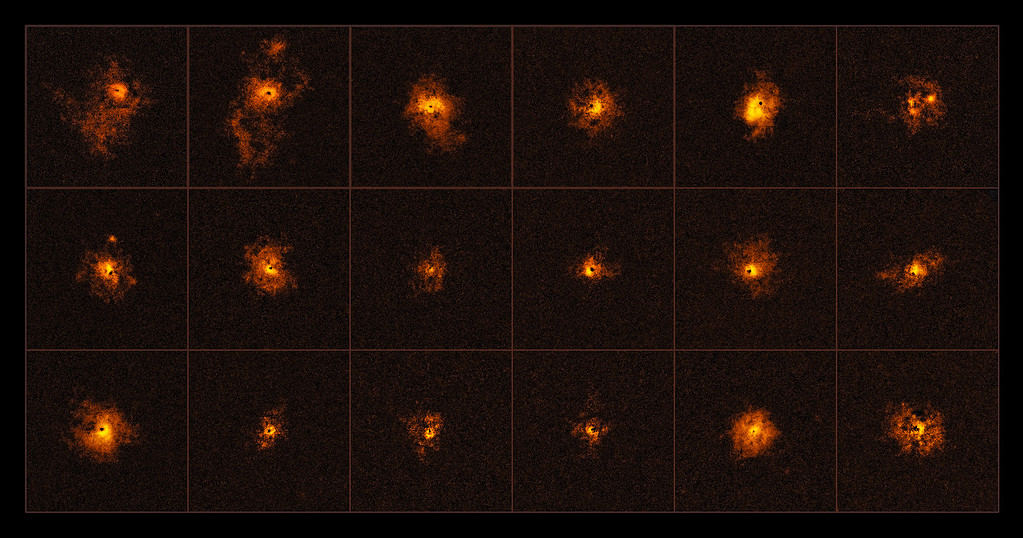It’s the behemoth that dwarfs all behemoths. A quasar — a fast-growing black hole — was found by researchers to grow incredibly quickly in size, accumulating one Sun’s worth of mass every day — close to the absolute maximum growth limit.
This single object is as bright as 500 trillion suns, or 20,000 times brighter than our whole Milky Way Galaxy. “We need to assume that this quasar is the most violent place that we know in the Universe,” says the lead author.

The maximum possible growth rate
A quasar is essentially a fast-growing black hole. Black holes are famously invisible because even light can’t escape them. They are only visible to our eyes when they expand (and through their gravitational effects). But quasar-type black holes are visible.
A quasar emits vast amounts of energy primarily because of the accretion of gas and dust into the supermassive black hole at its center. As material spirals into the black hole, it forms an accretion disk and heats up to extremely high temperatures due to gravitational and frictional forces, releasing immense energy in the form of light, x-rays, and other electromagnetic radiation. This process is incredibly efficient, making quasars some of the brightest objects in the universe.
“If they just sit there, they sit in darkness and neither emit nor reflect light. But when black holes eat, the matter that is their food is first drawn into what’s called an accretion disc, which is a holding pattern in which the material circles the black hole ever closer until it gets swallowed. A lot of heat is produced in the process that makes fast-growing black holes shine brighter than entire galaxies,” says lead author Christian Wolf from the Australian National University.
Quasars have long fascinated scientists. They feed voraciously on surrounding material, emitting tremendous amounts of light and energy, making quasars visible across billions of light-years. In fact, this particular quasar (called J0529-4351) emitted light that travelled 12 billion years to get to us.
“However, as the Universe continuously expands and is now larger than it was while the light travelled, the black hole is now further away than 12 billion light years, more like 24 billion light years,” Wolf mentions.
But even among these voracious cosmic feeders, J0529-4351 stands out. It essentially grows by the absolute maximum physical limit. Anything more, says Wolf, and the quasar would “choke on its appetite.” This limit, called the Eddington limit, is effectively a speed limit for growth — or how much the black hole “can take per time without getting hiccups, if you like” adds the researcher.
Huge, ancient, but not easy to spot

This particular quasar is a marvel of astronomy. It’s not just that it accumulates an ungodly amount of mass by gravitationally attracting everything around it, it’s that it did this for such a long time that it grew to an unimaginable size. It’s by far the most luminous object in the known universe — yet finding it wasn’t that easy.
“In a picture of the sky, taken by a telescope, quasars appear just like stars. The first quasar was discovered 61 years ago because it was a strong radio source that seemed to be coincident with a random blue star. But stars vastly outnumber quasars. So, we need information that distinguishes the two types and reveals the quasar-needle in the stars-haystack,” says Wolf.
As of recently though, much more good data is coming in from missions like the European Space Agency’s Gaia (which measures the motion of all the stars around us) or NASA’s Widefield Infrared Survey Explorer (WISE). In infrared, says Wolf, the colours of stars tend to be different from those of quasars, because stars have a single-temperature surface while the shining part of quasars have a blended mix of temperatures changing their colour. It’s not very obvious, but it gives astronomers something to go on.
We also don’t really know how big exactly this object is. Wolf says they estimate 17 billion solar masses — but it’s a wide estimate.
“Honestly the full uncertainty ranges technically all the way from 5 billion to 50 billion, depending on who you’d ask and what they would consider possible.” There are new instruments and the range will be pincered more and more, but estimating its total mass is still a work in progress.
The feeding frenzy is over
You shouldn’t be concerned about this behemoth, however. Not only is it extremely far away, but its feeding frenzy is already over, says Wolf. What we’re actually seeing now is what the quasar was like billions of years ago, during the earlier days of the universe.
“The age of the feeding frenzy is over, because gas in galaxies has mostly been turned into stars, and after billions of years the stars have got each other into orderly patterns: they are mostly on neat orbits around the black holes that sleep in galaxy cores. Even if a star dove suddenly down towards the hole, it would mostly perform a mere slingshot manoeuvre and escape again in a different direction,” the researcher told ZME Science.
“Our space probes use slingshot manoeuvres with the planet Jupiter if we can’t get them to a destination in the Solar System with mere fuel. But imagine some bad luck where a second space probe came the other way on a mirror manoeuvre in just the wrong moment — the two would crash into a debris cloud that would sit still for a moment before dropping like stones into Jupiter’s atmosphere. Such collisions were commonplace in the disorder of the young universe, and black holes were the early beneficiaries of the chaos.”
These gigantic black holes are also pretty rare to find. Wolf’s team has scoured almost the entire sky to find this behemoth.
This place is Hell
This all raises the question — what would a place like this really look like?
As Wolf describes it, Hell is a pretty good analogy.
“Hell has been imagined as a supremely uncomfortable place, hot and hostile to bodily forms of human life. Thanks to all-sky astronomy surveys, we have now found the possibly most hellish place in the Universe,” Wolf tells ZME Science.
Just to be clear, we don’t have any clear images of the place — the quasar appears as a dot on our telescopes. But that doesn’t mean researchers have no idea.
The accretion disk (the hazy debris orbiting around the black hole) is a whopping 7 light years across. That’s 1.5 times the distance to the closest solar system to ours, Alpha Centauri. This is not peaceful debris quietly orbiting the black hole, either. It’s a tumultuous hurricane swooshing, swirling, and crashing — with a devastating black hole in the eye of the storm.
The currents on the outer edge of this disk would reach tens of thousands of miles per second. Oh, and everything would be extremely hot, at tens of thousands of degrees. But it gets even better: the place almost definitely has strong magnetic fields and lightning bolts discharging everywhere, creating even more heat.
Seriously, you’d be hard-pressed to find any place that’s more hellish in the universe.
“I tend to describe it as the biggest gates to hell we have found anywhere in the Universe, because if you personally dropped into the accretion disc, apart from being air-fried and struck by lightning and all the rest, you’d end up most likely in the black hole from whence you shan’t return.”
But other than simply marveling at how extreme this object is (which is remarkable in and of itself), researchers will soon be able to use quasars to understand how the universe is expanding. Is it always expanding the same? Does this rate change — and if so, how does it change? These are important questions, and one of the big challenges of cosmology is to map the “expansion history of the Universe”.
Telescopes coming out in the next few years will be able to measure redshift (the phenomenon where light from an object in space stretches to longer and redder wavelengths as it travels) with unprecedented detail. With this knowledge, they will also be able to analyze how the universal expansion rate is changing.
So, in the end, these hellish places may turn out pretty useful. We just wouldn’t want to send any explorers there. Ever.
The study was published in Nature Astronomy.






